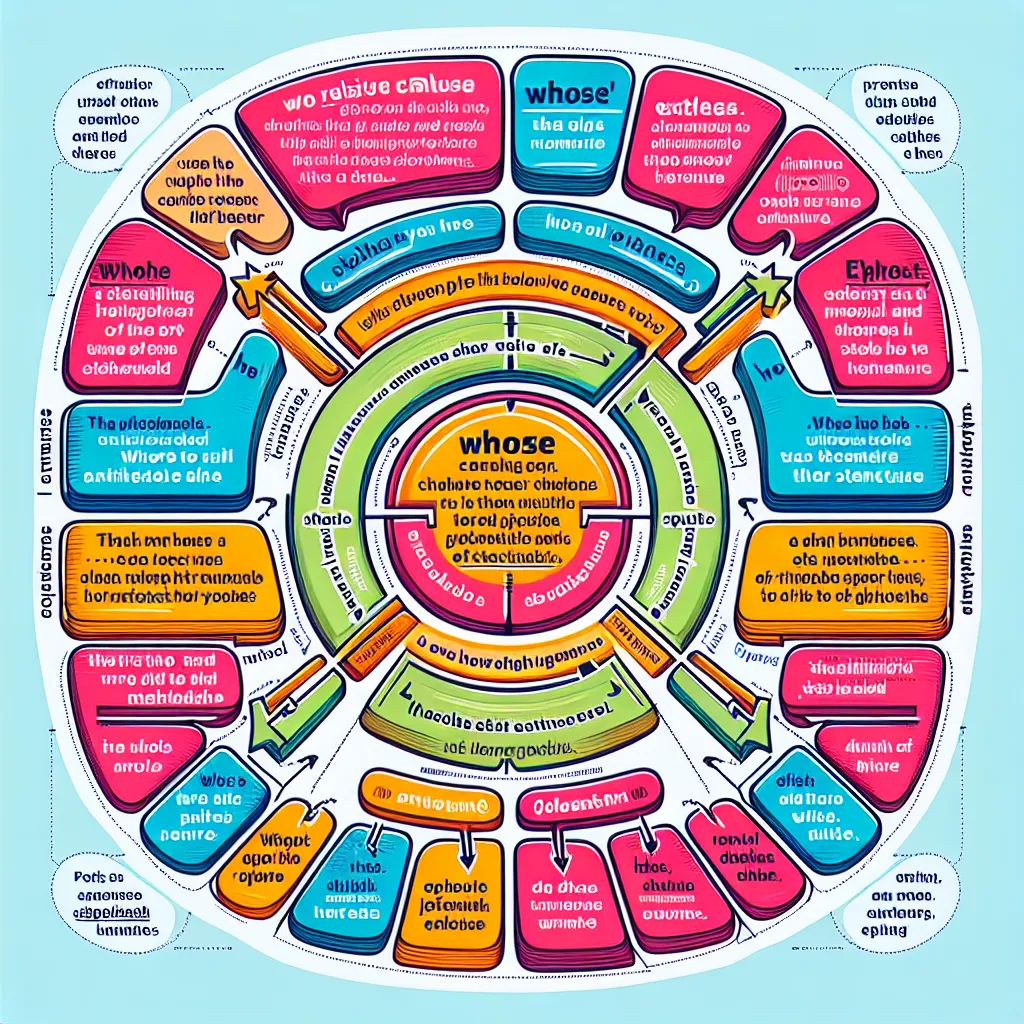Relative clauses with “whose” are an essential grammatical structure that frequently appears in IELTS exams. Understanding and using them correctly can significantly enhance your language proficiency and boost your IELTS score. In this article, we’ll explore the nuances of relative clauses with “whose,” provide examples, and offer tips on how to use them effectively in the IELTS test.
Nội dung bài viết
- Understanding Relative Clauses with “Whose”
- Basic Structure
- Using Relative Clauses with “Whose” in IELTS Writing
- Task 1: Academic Report Writing
- Task 2: Essay Writing
- Relative Clauses with “Whose” in IELTS Reading
- Utilizing “Whose” in IELTS Speaking
- Common Mistakes to Avoid
- Advanced Usage for Higher Band Scores
- Conclusion
Understanding Relative Clauses with “Whose”
Relative clauses with “whose” are used to provide additional information about a noun by showing possession or relationship. “Whose” is the possessive form of “who” and “which,” and it’s used for both people and things. This structure is commonly found in IELTS reading passages and can be effectively employed in writing and speaking tasks to demonstrate advanced language skills.

Basic Structure
The basic structure of a relative clause with “whose” is:
[Noun] + whose + [possessed noun] + [rest of the relative clause]
Let’s look at some examples:
-
“The scientist whose research revolutionized the field won a Nobel Prize.”
- Main noun: The scientist
- Possessed noun: research
- Rest of the relative clause: revolutionized the field
-
“The company whose products are eco-friendly is gaining market share.”
- Main noun: The company
- Possessed noun: products
- Rest of the relative clause: are eco-friendly
-
“The book whose author remains anonymous has become a bestseller.”
- Main noun: The book
- Possessed noun: author
- Rest of the relative clause: remains anonymous
In each of these examples, “whose” introduces additional information about the main noun by showing a possessive relationship.
Using Relative Clauses with “Whose” in IELTS Writing
Incorporating relative clauses with “whose” in your IELTS Writing task can demonstrate your ability to use complex grammatical structures. This can help you achieve a higher band score in the Grammatical Range and Accuracy criterion.
Task 1: Academic Report Writing
In Task 1 of the Academic IELTS Writing test, you might need to describe data or processes. Here’s an example of how you can use “whose” in this context:
“The graph illustrates the market share of five smartphone brands, whose sales figures fluctuated significantly over the past decade.”
In this sentence, “whose” relates to the five smartphone brands and provides additional information about their sales figures.
Task 2: Essay Writing
For Task 2, using “whose” can help you express complex ideas more concisely. Consider this example:
“Environmental protection is a critical issue whose importance cannot be overstated. Countries whose policies prioritize sustainable development are more likely to mitigate the effects of climate change.”
These sentences demonstrate how “whose” can be used to connect ideas and provide additional information efficiently.
Relative Clauses with “Whose” in IELTS Reading
In the IELTS Reading test, you may encounter passages containing relative clauses with “whose.” Understanding these structures can help you comprehend complex sentences more easily. For example:
“The study focused on urban planning strategies whose implementation led to significant improvements in city infrastructure.”
Recognizing that “whose implementation” refers back to “urban planning strategies” can help you grasp the meaning of the sentence more quickly.
Utilizing “Whose” in IELTS Speaking
Using relative clauses with “whose” in your IELTS Speaking test can showcase your advanced language skills. Here are some examples of how you might incorporate this structure:
-
Describing a person: “My mentor is someone whose advice I truly value.”
-
Talking about a place: “I grew up in a small town whose population has doubled in recent years.”
-
Discussing an event: “The festival, whose origins date back centuries, attracts tourists from all over the world.”
Common Mistakes to Avoid
When using relative clauses with “whose,” be careful to avoid these common errors:
-
Confusing “whose” with “who’s”:
- Incorrect: “The man who’s car broke down is my neighbor.”
- Correct: “The man whose car broke down is my neighbor.”
-
Using “whose” for inanimate objects (although this is becoming more accepted):
- Less natural: “The table whose leg is broken needs to be repaired.”
- More natural: “The table with the broken leg needs to be repaired.”
-
Forgetting to include a noun after “whose”:
- Incorrect: “The politician whose was criticized resigned.”
- Correct: “The politician whose policies were criticized resigned.”
Advanced Usage for Higher Band Scores
To aim for higher band scores (7 and above), try to use relative clauses with “whose” in more sophisticated ways:
-
Combining with other complex structures:
“The research paper, whose findings challenged conventional wisdom, has sparked a debate that is likely to reshape our understanding of the subject.” -
Using in passive constructions:
“The ancient artifact, whose origins were long debated by historians, has finally been authenticated.” -
Incorporating into cleft sentences:
“It was the innovative company whose groundbreaking technology revolutionized the industry.”
Conclusion
Mastering the use of relative clauses with “whose” can significantly enhance your performance in the IELTS exam. By incorporating this structure into your writing and speaking, you demonstrate a sophisticated command of English grammar. Remember to practice using “whose” in various contexts, and always ensure that your usage is clear and grammatically correct. With consistent practice, you’ll be able to use this structure confidently and effectively in your IELTS test and beyond.
To further improve your skills, try creating your own sentences using “whose” in different IELTS-related topics such as education, technology, environment, and social issues. This will help you become more comfortable with the structure and prepare you for any question that may arise in the exam.